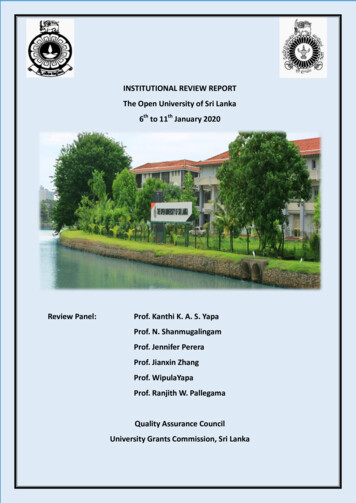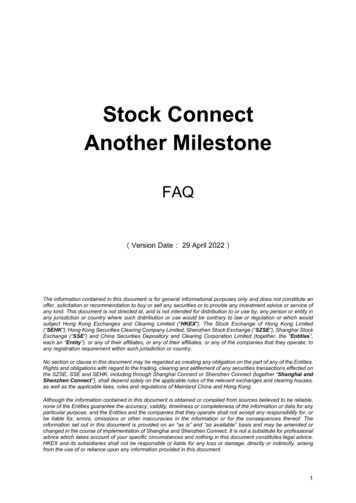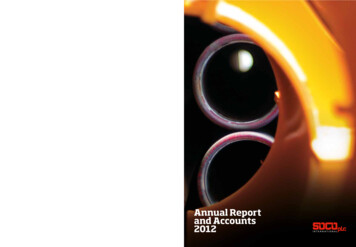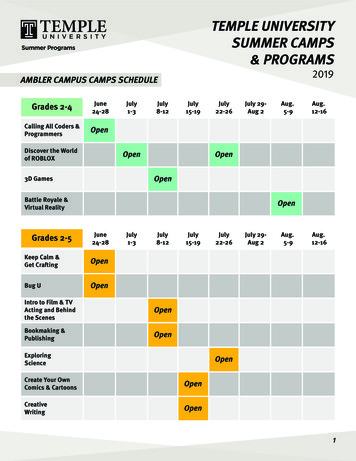
Transcription
INSTITUTIONAL REVIEW REPORTThe Open University of Sri Lanka6th to 11th January 2020Review Panel:Prof. Kanthi K. A. S. YapaProf. N. ShanmugalingamProf. Jennifer PereraProf. Jianxin ZhangProf. WipulaYapaProf. Ranjith W. PallegamaQuality Assurance CouncilUniversity Grants Commission, Sri Lankai
List of abbreviations and acronymsAVRCAudio Visual Resource CentreBBBBig Blue ButtonCAContinuous AssessmentCATContinuous Assessment TestCERCConsultancy and External Resource CentreCESSDCentre for Environmental Studies and Sustainable DevelopmentCERCExternal Resource CentreCETMeCentre for Educational Technology and MediaCGUCareer Guidance UnitCLOCourse Learning OutcomesCTHECertificate of Teaching in Higher EducationERCEthics Review CommitteeESAExternal Services AgencyGEEGender Equity and EqualityHSSHumanities and Social SciencesICTInformation Communication TechnologyILCIndustry Liaison CentreIQAUInternal Quality Assurance UnitIQACInternal Quality Assurance CellIRUInternational Relations UnitIRInstitutional ReviewITInformation TechnologyKPIKey Performance IndicatorLMSLearner Management SystemMISManagement Information SystemMOOCMassive Open Online CourseMOUMemorandum of UnderstandingPLOProgramme Learning Outcomesii
OBEOutcome Based EducationODLOpen Distance LearningOEROpen Educational ResourcesOMISOpen University Information Management SystemOUSLOpen University of Sri LankaQAQuality AssuranceQACQuality Assurance CouncilRSCRegional and Study centresSBSSubject Benchmark StatementSCLStudent Centred LearningSDCStaff Development CentreSESelf EvaluationSEESustainable Energy EngineeringSERSelf Evaluation ReportSGBVSexual and Gender Based ViolenceSLIDESri Lanka Institute of Distance EducationSLQFSri Lanka Qualifications FrameworkSMPStrategic Management PlanStart@OUSL Student Academic Readiness Training at OUSLTORTerms of ReferenceTRFTemporary Residential FacilitiesUGCUniversity Grants CommissionUMCUniversity Medical Centreiii
Table of ContentsPageSection 1 A Brief Introduction to OUSL04Section 2 Review Team's View of OUSL‘s Self-Evaluation Report07Section 3 A brief description of the Review Process11Section 4 An overview of the University's Approach to Quality and Standards13Section 5 A Commentary on the ten criteria of Institutional Review15Section 6 Grading of Overall Performance of the University31Section 7 Commendations and Recommendations33Section 8 Summary42Annexes44iv
v
Section 1 - Brief Introduction to OUSLThe Open University of Sri Lanka (OUSL) was established in 1980 under section 23(1) andsection 18 of the Universities Act No. 16 of 1978, and the OUSL Ordinance No. 3 of 1980recognizing the need of higher education opportunities for every Sri Lankan citizen. Later, in1990, this OUSL ordinance was replaced by a new oneand several amendments have beenincorporated since then. At the inception, the University has incorporated within its systemthe External Services Agency (ESA) and the Sri Lanka Institute of Distance Education(SLIDE).OUSL is the only national university under UGC which delivers academic programmesthrough Open and Distance Learning mode (ODL). OUSL provides access to studentsthroughout the country with a network of 09 Regional Centres and 19 Study Centres with themost recent opening at Matale. Its Study Programmes, nearly 65 and over 1500 courses, arestructured enabling students to progress academically from foundation and certificate levelsto master‘s and PhDlevels with lateral entry and early exit. OUSL offers many certificate anddiploma courses in addition to undergraduate courses under all faculties and students withvarying entry qualifications are allowed to register for programmes at different levels.The vision of the University is ―To be the premier open and distance learning institution inAsia through excellence, efficiency and equity in lifelong learning‖. Through this vision,OUSL has developed its mission aiming to provide education to people in all corners of thecountry. The mission of the University is ―To enhance access to high quality affordable andrelevant education through open distance education and ensure lifelong learningopportunities to face challenges in a knowledge society‖. The vision and mission of theUniversity is guided by set of values, which helps the University to achieve realistic goals.OUSL had started its academic activities with about 4000 students in 1980 and at present itsenrolment is more than 40000. It comprises of 06 faculties, Education, EngineeringTechnology, Health Sciences, Humanities & Social Sciences, Natural Sciences and newlyestablished Management Studies, with a total of 29 academic departments. Faculty ofManagement Studies has been excluded in this Institutional Review (IR). OUSL also hasseveral institutes/centres, Post Graduate Institute of English (excluded from this IR), Centrefor Environmental Studies& Sustainable Development (CESSD), Centre for EducationalTechnology & Media (CETMe) and Consultancy and External Resource Centre (CERC).Table 1 and 2 indicate students and staff at present, respectively and staff vacancies that existat OUSL. The University receives personal emoluments of the permanent staff from thegovernment and all other expenses are met through student tuition fees and income generatedby other means. The Table 3 indicates number of graduates that OUSL have produced duringlast few years.4
Table 1.1Number of Students at present under each 519Humanitiesand SocialSciencesNaturalScienceHealthScienceCommonto allfacultiesTotal1483940443986483639908Table 1.2 Number of staff at OUSL by 30th June, 2019Total approvedcadreStaff at presentVacancies3943355912911046228392514Academic staffAdministrative & Nonacademic staffAcademic support staffTemporaryDemonstrator/Instructor176Table 1.3 Number of Students Graduated between 2014 - 20172014No. of Bachelor’s degreescompleted / Total10412015YearNumber of Postgraduates completedMaster’s MPhil and 445149201819471778185OUSL had its last Institutional Review in 2013. The present review team was provided adocument stating that some of the recommendations given after the review in 2013have beenattended, though no information to that effect was provided in the current SER. It onlycontains some new initiatives and changes that have taken place after the 2013 InstitutionalReview without addressing to any particular recommendation given. OUSL had received thegrade ―confidence‖ according to the grading system existed at the time. The current reviewteam, after studying the document containing actions on recommendations of 2013 review,identified a few areas for particular scrutiny. These were (1) measures taken by OUSL toaddress recommendations of 2013 review, (2) evidence for adhering to best practices at alllevels within the University, (3) commitment to quality assurance and (4) otherimprovements that University may have made since last IR.5
In 2018, several programme reviews had been taken place, namely, BA Honours in Englishand English Language Teaching, BA in Social Sciences, Bachelor of Law Honours, Bachelorof Education Drama and Theatre, Bachelor of Education (Honours) in Natural Science andBachelor of Management Studies. However, the SER submitted for the current InstitutionalReview contains no information regarding any of the programme review outcomes.6
Section 2 – Review Team’s View of OUSL Self-Evaluation Report (SER)2.1 Preparation of SERThe commitment of OUSL to the Self-Evaluation (SE) process is evident as it had beeninitiated by Director/IQAU informing the members at the 364th Senate meeting held inOctober 2018 about the need of next IR to be carried out in 2019 and thus, the letter of intentwas sent to UGC. With the Senate approved procedure, the steering committee for SERwritingconsists of 19 senior academics and the AR/IQAU as the convener was appointedunder the Chairmanship of the Vice-Chancellor. Subsequently, 10 working groups, eachheaded by a steering committee member had been appointed for handling the task bycollecting evidence and writing under 10 criteria. Working groups were represented byacademic staff from faculties andheads of administrative divisions/unitsas relevant. Allworking groups and group chairs were provided with Terms of Reference (TOR). Severalworkshops on awareness in SER writing had been conducted for the working groups. Thougha few administrative officers were included in the working groups, there was no evidence toshow that administrative staff was included in the later stages of the process, in particular, inwriting of the SER.Academic staff, non-academic staff and students were made aware of the InstitutionalReview 2019 by IQAC chairpersons in the faculties. All staff had contributed to thepreparation of documental evidence. After draft documents of self-assessment under eachcriterion were prepared they had been compiled as the draft of SER which had beencirculated to steering committee members for verification and editing. The appointedEditorial Board had scrutinized the compiled SER for its accuracy and integrity. The finaldocument had been submitted to UGC after approval of the Senate/Council.2.2 Adherence to Instructions of Institutional Review ManualIt was somewhat unfortunate that completeManual for Distance and Higher EducationInstitutions was not available early enough for OUSL to grasp the whole concept of externalreview process and its requirements to prepare the SER in accordance with the instructions.However, OUSL had taken a courageous step to compile the SER even without the completeinstruction manual(especially, the best practices component) at hand, for which the reviewteam is very grateful.The SER is written with a good participatory approach as highlighted above. The SER iswritten according to the format given in the manual. The section on introduction to theUniversity describes the history, the faculties, Regional and Study Centres (RSCs), humanresources, etc. However, the information provided was not sufficient to paint a clear picturein the reviewer‘s mind on OUSL‘s academic entities and their academic responsibilities and7
functions. In particular, how RSCs function, their role in conducting academic programmes,the availability of human resources, etc., were not included in the SER.The progress made by the University since its last IR conducted in 2013 was not clearlydocumented in the SER with respect to recommendations provided by the review team andany remedial actions taken to rectify the weaknesses.Therefore, it is not clear from the SERhow University has adhered to recommendations given by the review team in 2013. Thoughthere had been several programme reviews taken place at OUSL during 2018, no mention inthe SER regarding their outcomes either.SER includes an analysis carried out by the Institution in terms of Strengths, Weaknesses,Opportunities and Threats (SWOT). In the SER, a large number of strengths (18), manyweaknesses (11), several opportunities (8) and some threats (6) have been identified. Thestrengths of the OUSL are (1) being the only national university to offer education throughODL mode, (2) offering university education to many, (3) a major portion of expenditurebeing financed by the government, (4) a great majority of students having cordial relationshipwith staff, (5) having a network of regional and study centres, (6) having lateral entry and exitpoints in study programmes, (7) study programmes catering to diverse needs of the country,(8) having an established procedure for evaluating prior qualifications of prospectivestudents, (9) having a multi-skilled academic and non-academic staff, (10) academic staffhaving broad research expertise, (11) having in-house expertise to produce learningresources, (12) having a good Management Information System, (13) having facilities andinfrastructure to develop online courses, (14) having effective professional developmentprogrammes for staff, (15) having a well-equipped printing press, (16) having a state of theart ―Media House‖, (17) having a well-resourced library and (18) the availability of preschools to train primary education teachers. One notable strength omitted in the report is thegrade of ―confidence‖, the Universityhad received after 2013 IR, the highest grade possible inthe scale used at the time.The University has identified following weaknesses; (1) limited senior academic andadministrative staff, (2) low completion rates of courses and study programmes by students,(3) not having a good programme for English language proficiency, (4) less commitment bystaff towards outcome based performance, (5) lack of interest by staff to ensure quality ofservices, (6) difficulty in attracting qualified temporary staff due to low rates of payments, (7)not implementing decisions/recommendations in timely manner, (8) academic staff isoverloaded with administrative responsibilities, (9) poor coordination among main entities,(10) less commitment to optimise resources and to reduce costs and (11) poor marketingstrategies to promote OUSL brand.Whether OUSL has made an attempt to prioritize the weaknesses and to initiate actionstowards rectifying any of them is not clear. Low graduation rates in many study programmeshad been identified when preparing the current Strategic Management Plan (SMP) in 2015,however, no firm effort has been taken to identify causes for such low rates over the yearsand to take any action to increase graduation rates. Though OUSL states that not having acomprehensive English programme as a weakness, there is no attempt by the administrationto provide a continuous self-learning tools for students to improve their English skills. The8
same weakness had been identified in 2015 during preparation of the current strategic plan.Section 5 of this report provides weaknesses that reviewers have identified under eachcriterion, but few major weaknesses that affected the quality assurance (QA) process as awholeare(i) not internalization and implementation of best practices, (ii) poor documentationand (iii) varying levels of awareness by academic and non-academic staff on the QA process.The opportunities available to OUSL according to the SER are (1) to expand the regionalnetwork, (2) increase number of students, (3) worldwide recognition of ODL mode, (4)collaboration with local and international partners, (5) to offer cross-border studyprogrammes, (6) increasing demand for higher education in remote areas, (7) economicdevelopment activities demanding qualified personnel and (8) demand for postgraduatequalifications. Though these opportunities had been identified in 2015 when current SMPwas prepared, how they could be used towards improvement of university services is notindicated in the SER. OUSL needs to take serious steps to capitalize on these opportunitieswhen planning its expansion and promotional activities.The identified threats are (1) reduction in state funding for development work, (2) lack ofunderstanding of the ODL system and its contribution to economic development of thecountry, (3) adoption of ODL mode delivery by conventional universities, (4) other overseasODL universities promoting their programmes in the country, (5) private institutions offeringattractive remunerations to staff and (6) difficulty in replacement of academics leaving theOUSL for greener pastures. SER could have included a section on how OUSL could initiatesome actions to mitigate at least some of the identified threats as they existed since 2015.Some threats such as recurrent student disturbances, ragging in the university andpoliticization of student unions have not been identified.A critical evaluation of the above findings of the SWOT analysis, on how strengths areelevating the status of the University, how alleviation of weaknesses could improveUniversity‘s function, how opportunities could be capitalized to promote OUSL activities andhow the impact of threats could be minimized strategically for the University to prosper,would have made the SER more complete and thorough. It is important for OUSL to revisitthe SWOT analysis done in 2015 during the preparation of the current strategic plan of 2015– 2020, to realize that even by end of 2019 some of the same weaknesses and threats stillexist and no remedial actions have been taken by authorities for all these years. This is anindication that the five-year Strategic Management Plan of the Universitybecomes justanother document produced by the authorities and no proper steps taken to monitor theprogress.SER contains vision and mission statements and several underlying values that eachindividual must have within, in order to achieve the OUSL vision. Though the stated valuesare highly respectable and praiseworthy, whether the responsible OUSL community has highregard to those values and whether those values are used as prime guiding lights whenserving its clienteleare somewhat questionable. SER mentions 7 strategic goals to beachieved, which are taken from the current strategic plan of 2015 – 2020. In the SMP,objectives and strategies to achieve the seven goals have been identified and stated, thoughmany strategies are not specific. Also, under each goal stated in the SMP,many Key9
Performance Indicators (KPIs) are listed, to be measured annually. However, no responsiblepersonnel have been identified to implement or carry out the proposed strategies or actions.Thus, a great majority of the KPIs has either not achieved at all or has achieved onlypartly/minimally by the end of 2019.Annual reports of OUSL do not reflect how much or upto what level each goal has been achieved because no attempt has been made to highlightprogress of any of the actions taken or outcomes achieved with respect to the statedobjectives/strategies in the SMP or as projected by the action plan of SMP.OUSL needs to do a thorough analysis on objectives and strategies under each goal in theSMP to identify why many planned activities have not been initiated or implemented,whether the plan itself was too much to achieve, whether identified KPIs were overlyestimated and what lessons can be learnt from some of the failures. Several serious brainstorming sessions would be required to understand clearly where OUSL was at the start of2015 and where it is by 2020 before making the next strategic plan. Also, it is very importantfor OUSL to have year-end meetings to record the progress it achieves with respect to theKPIs stated in the SMP and to publish the findings so that short comings could be identifiedand addressed within a reasonable time.10
Section 3 – A Brief Description of the Review ProcessThe institutional review process started with the pre-review meeting held at UGC on 05th July2019 with Prof. Nilanthi de Silva, Director/QAC for all reviewers. At the meeting, the teamof reviewers assigned for the OUSL review was handed over the SER and other relevantdocuments for the desk evaluation. The members of the review team and their affiliations aregiven below. Prof. Kanthi K.A.S. Yapa served as the review chair. Prof. Kanthi K. A. S. YapaProf. N. ShanmugalingamProf. Jennifer PereraProf. Jianxin ZhangProf. Wipula YapaProf. Ranjith W. Pallegama(University of Ruhuna)(University of Jaffna)(University of Colombo)(Yunnan University, China)(University of Colombo)(University of Peradeniya)After the desk evaluation was submitted, a pre-site visit meeting was organized by QAC on02nd August, 2019 to discuss the review process. The team discussed the SER, assigned tasksfor each member and prepared a tentative agenda for the site visit. The tentative schedule wassent to Director/IQAU at OUSL for finalizing. The review team conducted the reviewbetween 6th – 11th January, 2020. The final schedule of the visit is attached to this report asAnnex 3.1. The team arrived at the Hotel in the evening of the 5th and discussed the SER andplanned detail inquiries and meetings. The list below shows the assigned criteria for eachreviewer for checking documents and evidence submitted. Prof. Kanthi K. A. S. YapaProf. N. ShanmugalingamProf. Jennifer PereraProf. Jianxin ZhangProf. Wipula YapaProf. Ranjith W. PallegamaCriteria 1, 2, 5, 6 and 8Criteria 2, 3, 4 and 10Criteria 3, 5, 7 and 8Criteria 2 and 10Criteria 1, 2, 7 and 9Criteria 4, 6 and 9The review team discussed the schedule with the Director/IQAU and made final adjustmentsto the agenda before the commencement of the review process. The Vice Chancellor ofOUSL presented an overview of the University in relation to 10 criteria of the review at thefirst meeting held on the 6th. During the first four days of the visit, the six-member team wasdivided into two groups to have discussions in parallel sessions with all stakeholders;academics, non-academics, sample of students from each faculty, alumni, centredirectors/coordinators, etc. Through these discussions the team identified some areas thatrequire particular scrutiny. The review team visited all faculties, divisions, centres, theLibrary, canteens, the temporary residence for students, sports facility, sample of laboratoriesand lecture/day school rooms, computer labs, etc. to get a firsthand experience of quality offacilities available for staff and students. At the end of each day, the team inspecteddocuments extensively and discussed the plan for the following day. All documents werearranged systematically in a comfortable room where review team could sit and scrutinizethem with ease. The review team was very satisfied with the support given by the IQAU11
office staff and the facilities provided by them. On the fifth day of the visit, the team dividedinto three groups to visit few regional centres located in Kandy, Matara, Ratnapura andKurunagala and few study centres in Kalutara, Gampaha, Ambalangoda and Ambalantota.The review team extends its gratitude to all centre directors and academic and other staffmembers and students for their cordial reception and kind corporation extended to the teamduring the visits.The visit was concluded on the 11th morning with a meeting with the Vice Chancellor,Deputy Vice Chancellor, Deans, Librarian, Registrar, Director/IQAU, Directors ofcentres/units, SER writers and other senior academics. The team presented a summary onstrengths and weaknesses found and commented on few issues that needed immediateattention. The Vice Chancellor responded to many weaknesses highlighted at the meetingwith a promise to rectify them as early as possible.12
Section 4 – Overview of the University’s Approach to Quality andStandardsIn the IR manual for Sri Lankan Distance and Higher Education Institutions, only six specificstandards are kept for evaluation of the quality assurance process (1.19 - 1.24). Thesestandards reflect more about QA policies and thus, comments regarding them will bediscussed under criterion 1 in section 5 of this report. In this section, some specific detailsand practices of the quality and standards are highlighted.OUSL had initiated its QA activities in 2004 with a Senate approved committee and theIQAU had been established in 2012 with an increased QA membership to include seniormanagement and other administrative officers. The present IQAU has a Board ofManagement consisting of the Director/IQAU as the Chairman, Vice-Chancellor or DVC inattendance, Deans, Librarian, Directors, Registrar, Bursar and coordinators of IQACs ofFaculties and a secretary (AR) according to the 2019 UGC circular. The review teamobserved the approach by OUSL to quality assurance process during the site visit period andit is at a satisfactory level and there is a high potential to improve further. IQAU has beenfairly active, but IQACs in some faculties are not active to the same extent.Good quality assurance process and best practices are vital for a successful outcome of anexternal evaluation. Internal quality assurance process needs to be internalized to all day-today activities within the University. The review team experienced considerable interestshown by all stakeholders about QA. However, there have been some shortcomings whenwriting the SER, mainly, not giving details about faculties and their functions, not includingthe recommendations of previous IR and how they have been addressed and not reporting theoutcomes of programme reviews. Also, many statistical and tabulated data about OUSL staff,students, programmes offered, graduate information, etc. were missing in the SER, whichcould have been easily attached as Annexes to the SER. OUSL had not appointed anexperienced internal review panel (other than an editorial board)to evaluate the SER or tocheck validity, relevance or appropriateness of collected documental evidence for eachstandard under each criterion. The outcome of not conducting an internal review affectsheavily on the evaluation process, for example, the review team found irrelevant documentsprovided for many standardsor sample/incomplete evidences provided only from a fewfaculties for some standards even when examples exist in other faculties. Also, there weredocuments with no date, no authorization or as unfilled forms. A thorough internal reviewcould have avoided such lapses easily. Review team recommends that more senior academicsto get involved in the institutional and programme review processes of other universitiesbecause that experience will surely improve the quality of the University and its programmes.The review team found that the recommendations of 2013 IR have not been addressedcompletely from the document provided (in addition to the SER), the document neither had adate nor a signature by any authority. One of the major recommendations stated was toreform the organizational structure to suit ODL mandate and a new and comprehensiveordinance to be proposed and approved. However, the proposal is still being studied by the13
legal officer after approval by the Senate. Out of 13 recommendations, only about six havebeen addressed to a satisfactory level whereas other recommendations have not beenaddressed at all or have been addressed only partly. It is important to identify responsiblepersons to address and monitor those recommendations with a timeline to complete them. Itis very important that IQAU monitor the recommendations given in this report and push theauthorities to complete them before the next IR.The IQAU website needs to be updated. Regular activities of IQAU as well as IQACs need tobe highlighted on the website for it to appear more dynamic. Internal quality assuranceactivities need to take place continuously and a schedule of quality promotional activitiesshould be uploaded to the website as a monthly planner. QA by-laws should be available onthe website as well. Online programme/course evaluation and student feedback mechanismshould have some uniformity among all faculties. IQAU and IQACs need to monitor andencourage all stakeholders to do online evaluations.Analysis of the surveys, as relevant, couldbe uploaded on the IQAU website.14
Section 5 – Commentary on the Ten Criteria of Institutional ReviewAnalysis of the institutional review of OUSL by the team in relation to ten criteria is stated inthis section. As there were similar standards under different criteria, the analysis includedthem at relevant places avoiding repetition as far as possible.Criterion 1: Vision, Mission and PlanningThe OUSL ―Vision‖ and ―Mission‖ statements are in full compliance with the objective ofproviding high quality education to a wider sector of students and is a clear reflection of theUniversity‘s commitment to ODL. Seven strategic goals and action plans and KPIs undereach of these strategic goals have been identified, providing the basis for key operations ofthe University. OUSL has adopted the participatory approach in developing the SMP withdiscussions having been held at the Council, Senate and Faculty Board levels involving awider sector of the academic community. The University has developed several importantpolicies such as Codes of Practices and Academic Accountability, Code of Prevention andRedress of Sexual Harassment, Work Norms, Guidelines for copy right etc., to name a few.However, it is equally important that Vision, Mission and the Action Plans are periodicallycommunicated to all stakeholders and their feedback is obtained. There is evidence to showthat the information is disseminated and discussions have been held between externalconsultants and the senior staff members at Council and Senate levels. However, adequateevidence was not provided in the form of feedback forms, minutes of various committeemeetings or evidence for interaction with other stakeholders. Whether there had been agreater dialog among all relevant stakeholders seeking their viewpoints was not evident.Although Vision and Mission statements appear in the University website, they areconspicuously absent in the OUSL standard documents such as hand books, prospectuses orbrochures prepared for distribution among the prospective students. The review team is of theview that the OUSL could have more effectively utilized all available avenues/modes tocommunicate Vision and Mission at the level of Faculty Boards, and using all availableresources to other categories of the stakeholders, especially the current and prospectivestudents. Several policies could have been disseminated as internal circulars giving themwider publicity. Most of these documents are not uploaded to the University website. Thesecould be made available under IQAU publications, so that there is easy access to suchdocuments.It appears that some quarters of the staff and a great majority of the students are not aware ofsome of the very important policies developed by the OUSL. For example, a majority ofacademic and non-academic staff members were not aware that there is a document onPrevention and Redress of Sexual Harassment. Thus, although it is commendable that th
The Open University of Sri Lanka (OUSL) was established in 1980 under section 23(1) and section 18 of the Universities Act No. 16 of 1978, and the OUSL Ordinance No. 3 of 1980 recognizing the need of higher education opportunities for every Sri Lankan citizen. Later, in











